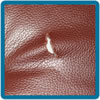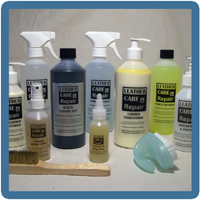Leather Care Information & Advice
How Leather is Made | Types of Leather | Product Help | General Leather Care Tips
Things to Avoid getting on Leather
With all type of leather there are certain things you should avoid spilling or getting in contact with leather. This varies with different types and finishes but generally you should not let things like sun block, hair spray, perfume, nail varnish near leather, but we have also been called in to repair damage caused by flee powder and even yoguart. Most liquids with alcohol or solvent in can cause anything from colour loss to leather literally dissolving.
This also applies to certain wipes which contain alcohol or leather ink removers which you can find on the internet.
Although all of these things can damage leather but the most common problem is with Tu-Tone leather, where the colour is made up of a base colour and a top coat to create a deep and interesting finish that changes colour in sunlight. Most of these things will remove the top coat and you will end up with a light area where it has come into contact. If this does happen though it is possible to repair this.
How to Care For Different Types of Leather
Protected Leather
Protected leather can easily be maintained. Its protective finish makes it easy to clean and then once its clean you can apply a conditioner to help protect it from dirt, keep it supple and give it a nice feel and smell. If you clean protected leather it is essential to condition it afterwards, as cleaning it can leave it dry and make it more prone to wear. By conditioning it you not only help to protect it but you will also find it is much easier to clean time and time again.
When to Clean & Condition
If you buy a new sofa you really don't need to do anything straight way. Most good conditioners do provide a slightly shinier finish and as new leather has a nice matt finish its nice to keep this for as long as possible. Other than that you can apply conditioner straight away to make it easy to clean when it gets dirty. Generally the time to start applying products to a new sofa or car seats for example, is when you can physically see the dirt forming on the surface. This is not always easy to see on dark coloured leather but the way to tell if its dirty is by the shine. Again new leather normally comes with a matt finish, if it starts to become shiny this is because of the dirt. Basically the dirt causes the shine.
To remove the shine you simply need to remove the dirt by cleaning it to restore the matt finish and then apply conditioner to protect the leather again. The frequency in which you need to apply products simply depends on how much use the leather has. We would recommend cleaning it when it has become dirty. If it is not dirty you may just want to condition it once every couple of months to help protect it from the elements such as sunlight or salt if its a boat or even if you live near the sea. The conditioners we use will also remove dirt so if its only slightly dirty the conditioner may be all you need to get it looking new again.
Suede & Nubuck Leather
Suede & Nubuck leather is fairly easily be maintain. Things to avoid getting on this type of leather are oil based products, as these can soak deep into the surface and if left for too long will dry and cause a stain. Most spillages such as coffee, squash and wine can be removed but they really need to be treated quickly and not left to dry. Suede & Nubuck is not something that requires conditioner but you can apply a waterproof protectant to provide a protective layer that will help to repel liquid making it more durable and easier to clean.
When to Clean, Condition or Protect
For this type of leather it is always good to buy some cleaner so you have it ready should you spill anything onto it. The most important thing is to treat any spillages quickly and before they dry so having a cleaner on hand should something happen makes sense.
Waterproof protectant is a water based product, which is clear and wont alter the look or the feel too much so can be applied at any time to avoid spillages soaking in and will help to provide a protective layer on new and old products.
Aniline Leather
Aniline Leather is very difficult be maintain and just about anything including water can cause a stain on this type of leather. As it has no protective finish any dirt or dust forms on the surface and then moves deeper into the leather. After a while you may find that even a drop of water will cause a clean spot where it has landed or a dark spot where it has mixed with the dirt.
When to Clean, Condition or Protect
Generally a waterproof protectant is the best way to maintain this type of leather as it helps to protect the surface from dirt and spillages. It is just about impossible to fully clean this type of leather so this is not recomended. All you can really do is treat a stain if it occurs quickly before it dries. Having a cleaner on hand is a good idea should this happen as you stand a good chance of removing it if it is still wet.
You can apply conditioner to Aniline leather to keep it supple and give it a longer life.
Faux Leather
Faux leather is easy to clean with its protective surface but if you do its important to protect it afterwards, otherwise it will become dry, which can cause cracking or splits occurring.
When to Clean, Condition or Protect
It is really best to avoid applying products to faux leather completely. Should it get dirty you can use a gentle cleaner on it and then apply a protective gel to protect it from the elements. Generally its a case of avoiding it getting to dry either by sunlight or by over cleaning it and not protecting it afterwards.
Vinyl
Vinyl is very similar to Faux leather. It is easy to clean with its protective surface but if you do its important to protect it afterwards, otherwise it will become dry, which can cause cracking or splits occurring.
When to Clean, Condition or Protect
Vinyl is pretty hard wearing and you can clean it if and when you need to. Should it get dirty you can use a gentle cleaner on it and then apply a protective gel to protect it from the elements. Like Faux leather its a case of avoiding it getting to dry either by sunlight or by over cleaning it and not protecting it afterwards.












